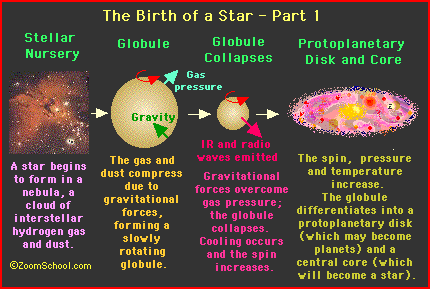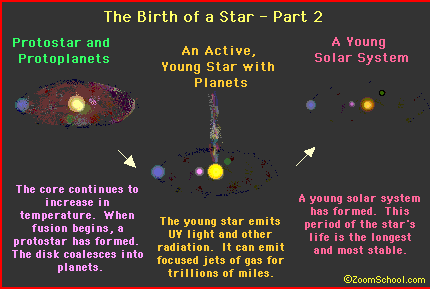
 |
| You might also like: | Sunspots | Death of the Sun - Zoom Astronomy | The Sun | Sun's Rotation - Zoom Astronomy | Solar Flares, Prominences, and the Solar Wind | Today's featured page: Whale Connect-the-Dots |
| Table of Contents | Enchanted Learning All About Astronomy |
Site Index |
| Our Solar System | Stars | Glossary | Printables, Worksheets, and Activities | ||||||
| The Sun | The Planets | The Moon | Asteroids | Kuiper Belt | Comets | Meteors | Astronomers | ||
| THE SUN |
| Introduction to the Sun | Solar Structure | Size, Mass | Flares, |
Sun's Birth | Solar Eclipses | Activities, Web Links |
|---|---|---|---|---|---|---|
| Solar Rotation | Sunspots | Sun's Death |
 The Sun, like other stars, was formed in a nebula, an interstellar cloud of dust and gas (mostly hydrogen). These stellar nurseries are abundant in the arms of spiral galaxies (like our galaxy, the Milky Way).
The Sun, like other stars, was formed in a nebula, an interstellar cloud of dust and gas (mostly hydrogen). These stellar nurseries are abundant in the arms of spiral galaxies (like our galaxy, the Milky Way).


Enchanted Learning®
Over 35,000 Web Pages
Sample Pages for Prospective Subscribers, or click below
|
Overview of Site What's New Enchanted Learning Home Monthly Activity Calendar Books to Print Site Index K-3 Crafts K-3 Themes Little Explorers Picture dictionary PreK/K Activities Rebus Rhymes Stories Writing Cloze Activities Essay Topics Newspaper Writing Activities Parts of Speech Fiction The Test of Time
|
Biology Animal Printouts Biology Label Printouts Biomes Birds Butterflies Dinosaurs Food Chain Human Anatomy Mammals Plants Rainforests Sharks Whales Physical Sciences: K-12 Astronomy The Earth Geology Hurricanes Landforms Oceans Tsunami Volcano |
Languages Dutch French German Italian Japanese (Romaji) Portuguese Spanish Swedish Geography/History Explorers Flags Geography Inventors US History Other Topics Art and Artists Calendars College Finder Crafts Graphic Organizers Label Me! Printouts Math Music Word Wheels |
Click to read our Privacy Policy
| Search the Enchanted Learning website for: |